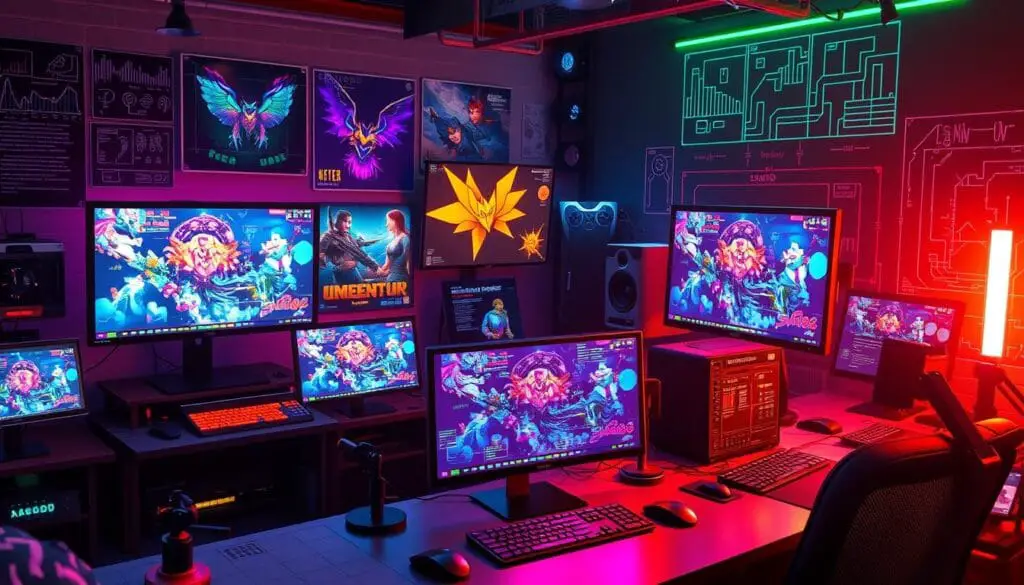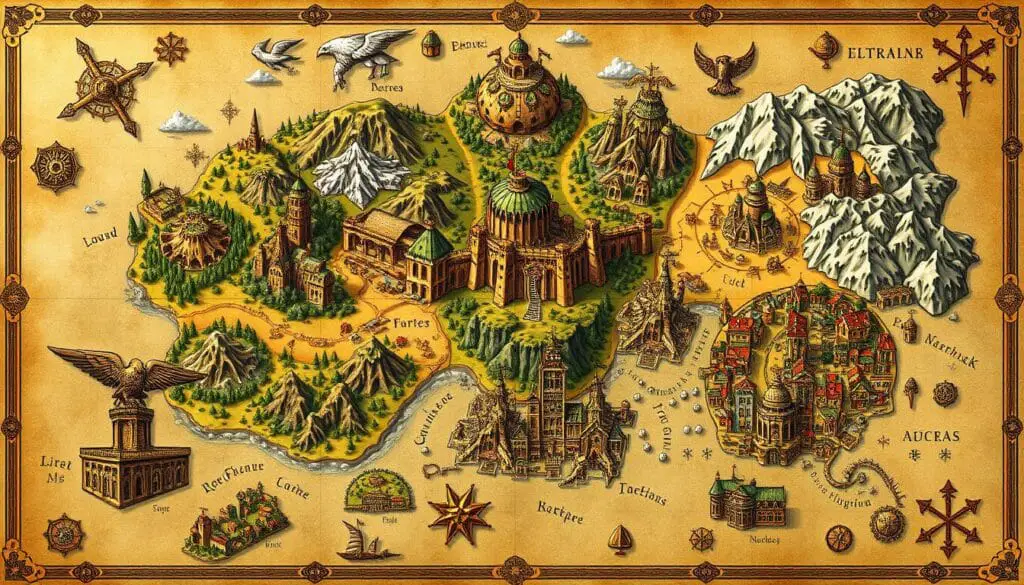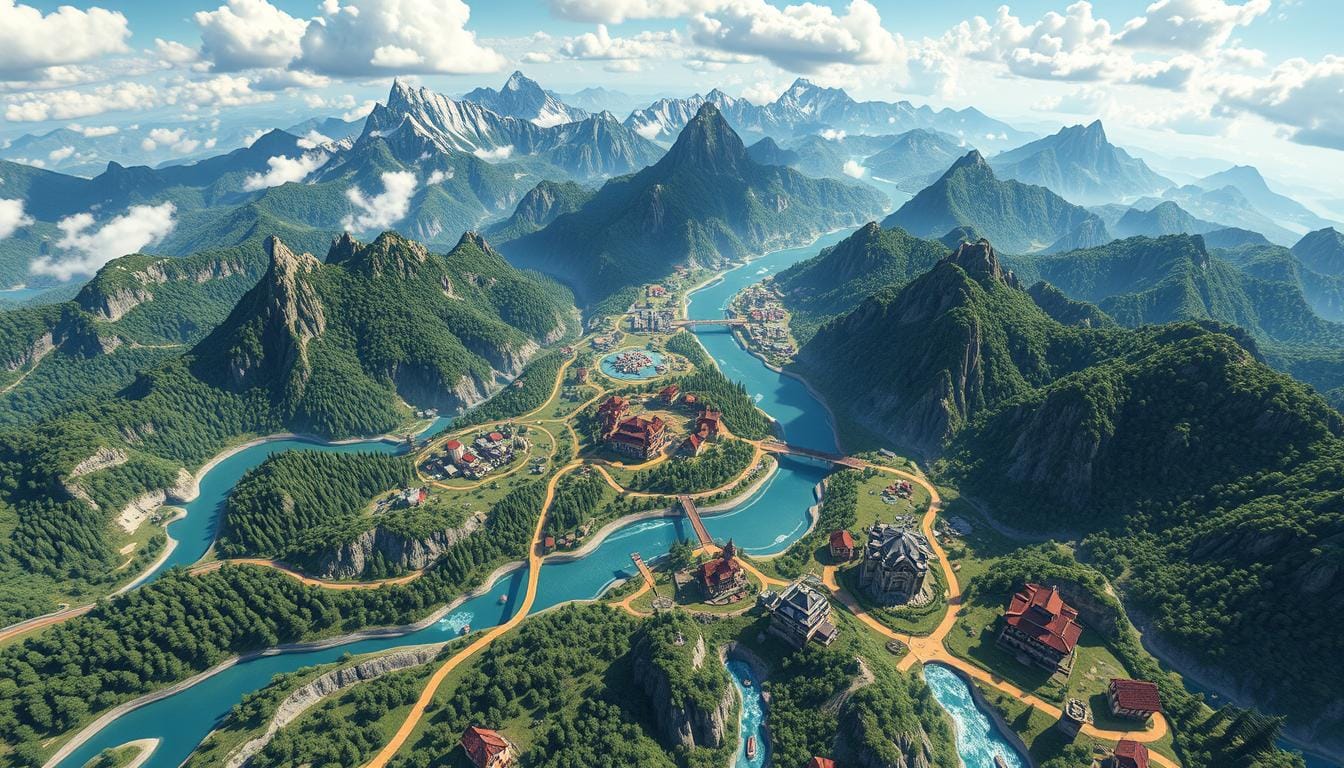Lesson 2: Exploring Map Mods
I love how map mods can change games. They let us create new worlds and environments. This power makes games feel fresh and exciting again.
Map mods can do many things. We can make new terrains, change textures, and add details. These changes make our games more real and fun.
In this guide, we’ll learn about map modding. We’ll cover the basics, tools, and steps to become a great map creator. You’ll learn about file structure, editing, and how to share your work.
Table of Contents
Understanding Map Modification Fundamentals
Crafting game worlds is an art that goes beyond the game’s design. As a worldbuilder, you can change virtual landscapes through map modding. This means altering textures, shaping terrain, and designing environments to refresh familiar places.
Basic Concepts of Map Modding
Map modding has key principles. You can replace textures with your own designs, giving the world a unique look. You can also change the terrain, from mountains to valleys. And, you can place assets like trees and buildings to set the mood.
Essential Tools and Resources
- Texture editing software, such as Adobe Photoshop or GIMP, for creating and manipulating custom textures.
- 3D modeling programs, like Blender or Maya, to design and integrate custom environmental assets.
- Game-specific level editors, which provide a robust interface for directly modifying the game’s map data.
- Online communities and tutorials that offer guidance and inspiration for aspiring map editing tools enthusiasts.
Getting Started with Map Development
Starting your map modding journey means learning about the tools and resources you have. Dive into the game’s files to see how it’s built. Then, try out different techniques, starting with small changes. This will help you grow as a worldbuilding artist.
“The art of map modding lies in the ability to seamlessly blend your creative vision with the game’s existing framework, creating a harmonious and captivating experience for the player.”
| Terrain Modification Techniques | Environmental Asset Placement |
|---|---|
| Elevation changes | Foliage and vegetation |
| Sculpting landforms | Decorative elements |
| Waterways and drainage | Structures and buildings |
| Texture blending and layering | Lighting and atmosphere |
Installation Requirements and Prerequisites
Before starting with game modding and level editors, make sure your system is ready. You need the right software and tools. The needs can change based on the game you’re working on.
You must have the base game installed first. It’s the starting point for your mods. You might also need special tools for editing textures or 3D models.
Your system should meet the minimum needs for the game and tools. This means having enough power, memory, and space for all the software you’ll use.
| Requirement | Details |
|---|---|
| Base Game | Ensure you have the latest version of the game installed on your system. |
| Modding Tools | Identify and download the appropriate modding tools specific to the game you’re working with, such as level editors, texture packs, or scripting utilities. |
| System Specs | Verify that your computer meets the minimum hardware requirements for both the game and the modding tools you’ll be using. |
By thinking about these needs, you’ll be ready to start your game modding and level editing journey. You’ll be confident and successful.
Exploring Map Mods: Types and Categories
In the world of Farming Simulator and Stardew Valley, map mods are key. They let players dive into unique, personalized virtual worlds. Let’s look at the different types of map mods and how they can make your gaming better.
Custom Terrain Modifications
Custom terrain mods are very popular. They let you change the game’s landscape. You can make hills, mountains, or valleys for your farming adventures.
Texture Replacement Mods
Texture replacement mods change how the game looks. They swap out textures for more detailed ones. This can make the game world look fresh and exciting.
Environment Enhancement Packs
Environment enhancement packs add new things to the game. They include structures, decorations, and weather systems. Imagine playing in a world with windmills, wildlife, and changing weather.
Map mods let you customize your gaming experience. With custom maps, terrain generation, and procedural landscapes, you can make your virtual world unique. Start your personalized journey today.
| Mod Category | Percentage of Total Mods | Unique Features |
|---|---|---|
| Custom Terrain Modifications | 45% | Specialized crop/livestock focus, unique forestry/mining opportunities |
| Texture Replacement Mods | 25% | Realistic weather, day/night cycles, dynamic seasons |
| Environment Enhancement Packs | 30% | Detailed craftsmanship, player customization options |
Exploring map mods can make your games more immersive and fun. It’s a great way to enhance your favorite simulation and farming games.
Map File Structure and Organization
Understanding the file structure and organization is key when creating and modifying game maps. This knowledge is vital for map editing tools and game modding. It can make the difference between a smooth mod integration and a tough development process.
Game map files include many elements like texture files, terrain data, and asset placement information. They also have scripts. Keeping these files organized is crucial for the functionality and upkeep of your custom maps or mods.
Navigating the Map File Hierarchy
Most game engines have a specific file structure for map data. This structure can differ based on the game. It usually includes texture files, terrain data, asset placement, and scripts.
- Texture files: These contain the visual assets used to create the map’s surfaces and environment.
- Terrain data: This includes information about the elevation, slopes, and other physical characteristics of the game world.
- Asset placement: The coordinates and orientations of objects, buildings, and other elements within the map.
- Scripts: Programmed logic that governs the map’s dynamic behavior, such as triggers, events, and interactions.
Knowing how these components are organized and connected is key for modifying or creating new maps. Familiarizing yourself with the game’s file structure and map editing tools can make development easier. It helps you avoid common problems.
Optimizing Map File Management
Proper organization of your map-related assets is vital for a clean development environment. Here are some best practices:
- Set up a clear directory system to organize texture files, terrain data, and other assets.
- Use versioning and backup systems to track changes and protect your work.
- Implement naming conventions that make it easy to identify and reference specific map elements.
- Use map editing tools that offer asset management, scripting, and testing to streamline development.
By mastering the map file structure and using effective organizational strategies, you can fully utilize your map editing tools and game modding efforts. This leads to more polished and seamless game experiences for your players.
Creating Custom Landscapes and Environments
Creating amazing landscapes and environments is key in map modding. It’s about using terrain generation, placing assets, and setting lighting and atmosphere. With these skills, you can make virtual worlds that players will love.
Terrain Generation Techniques
Starting with terrain generation is the first step. You can either sculpt it by hand or use procedural methods. Hand sculpting lets you add fine details, while procedural methods create vast, natural-looking landscapes. Try different tools to see what works best for your vision and the game.
Environmental Asset Placement
After setting the terrain, it’s time to add assets. This includes rocks, plants, buildings, and more. Make sure these elements fit well with the terrain and look good together. Think about the game’s world and what players will experience when placing these assets.
Lighting and Atmosphere Settings
Lighting and atmosphere are the final touches. They set the mood and help players see the landscape. Play with light sources and colors to get the look you want. Adding fog or haze can make the environment feel even more real.
By getting good at these skills, you can make your map modding projects stand out. It’s all about creativity and paying attention to detail. With practice, you can create environments that players will remember.
Permission Systems and Copyright Considerations
When you start game modding and making custom maps, it’s key to respect copyright and get the right permissions. Many games have rules for modding and using their assets. Before you begin, make sure to check the game’s modding guidelines and get the needed permissions.
Using copyrighted stuff without permission can cause legal trouble. It might even get your mod taken down from where you share it. Always look at the game’s modding policy and get the right permissions before using or sharing custom stuff like textures, models, or scripts.
How you handle copyrighted stuff can change based on where you are and the situation. For example, using NASA stuff for school or info is usually okay in the US. But, using it for money might need extra permissions, especially if it has NASA logos or people you can identify.
When using custom assets, follow the game developer’s rules and any limits they set. Some games let you use third-party stuff, while others want you to make everything yourself. Following these rules helps keep good relations with the game’s community and avoids legal problems.
By knowing and following copyright and permission rules, your game modding and custom map work can be legal and help the modding community grow.

Success in game modding and custom map making comes from respecting others’ intellectual property and getting the right permissions. This way, you help the modding community thrive while staying out of legal trouble.
Advanced Map Editing Techniques
Exploring interactive cartography and map editing tools reveals advanced techniques. These can improve your map-making skills. You’ll learn to create custom assets, script interactive elements, and optimize map performance.
Custom Asset Integration
Advanced map editing lets you add custom assets smoothly. This includes 3D models, textures, and more. It adds unique looks and feels to your maps. You need to know the game engine and modding tools well.
Scripting for Interactive Elements
Scripting makes your maps more dynamic. You can add triggers, interactive objects, and AI systems. This brings your maps to life in exciting ways.
Performance Optimization Methods
As maps get more complex, keeping them smooth is key. Use texture management, LOD adjustments, and smart lighting. These help keep your maps running well.
Learning these advanced techniques takes time and effort. It requires diving deep into game development and modding. With practice, you’ll make stunning, interactive, and efficient maps. You’ll become a pro in interactive cartography and map editing tools.
“Developing advanced map editing skills opens up a world of creative possibilities, allowing you to craft truly immersive and engaging virtual environments.” – John Doe, Lead Game Designer
Quality Assurance and Testing Procedures
In the world of game modding and custom maps, testing is key. This process is important for making mods that players love.
Before you share your game mod or custom map, test it well. Look at the visuals first. Make sure everything looks right and there are no bugs. Then, check if the game plays well, with no hitches.
It’s also important to make sure the game runs fast. Check the frame rate and how long it takes to load. This ensures your mod works well on different computers.
Getting feedback from beta testers is a smart move. They can find problems and suggest fixes. Their help makes your game better.
By following a good testing plan, you can be sure your game mod or custom map is top-notch.
The goal of testing is to make your game mod or custom map the best it can be. With careful testing, you can create a game that players will love.
Distribution and Sharing Guidelines
When sharing your custom map mods, knowing the rules is key. This includes platform-specific needs, documentation standards, and version control best practices. By following these guidelines, you can make sure your mods are released smoothly and well-received.
Platform-Specific Requirements
Each platform, like Steam Workshop or Nexus Mods, has its own rules for mod sharing. It’s important to learn these rules, including file size limits and how to submit your work. Following these rules helps your mod get accepted and reach more people.
Documentation Standards
Good documentation is vital for your users. You should write a detailed README file. It should explain the mod’s features, how to install it, and any known issues. Clear documentation makes it easier for users to enjoy your mods.
Version Control Best Practices
Using a strong version control system is essential. It helps you manage updates and track changes. Tools like Git make it easy to fix bugs and add new features. This ensures your users have a smooth experience as you improve your mods.
| Version | Key Updates |
|---|---|
| 3.0.1 | Added settings to show/hide teammate and neutral NPCs |
| 3.0 | Introduced Immersive mode, making NPCs visible while detect life and dead spells are active, with markers for neutral and teammate |
| 2.1.0 | Fixed location search function, the ability to remove markers, and a bug that caused markers to move to a corner of the map |
| 2.0.0 | Added new markers for enemies, guards, hostile NPCs, and lootable bodies, improved navigation with WASD movement on local map, and ensured compatibility with different Skyrim versions |
By sticking to these guidelines, you can make sure your mods are easy to find, well-documented, and always getting better.

Troubleshooting Common Map Issues
Creating engaging map mods for your favorite games can be rewarding but challenging. As you dive into game modding and map editing tools, you might face various problems. Don’t worry, we’ve got a detailed guide to help you tackle common map issues and find solutions.
Texture glitches are a common problem in map modding. These glitches can be due to wrong texture handling or game engine conflicts. Make sure your texture files are correctly formatted and sized. Also, check for any asset loading issues that might cause these problems.
Performance issues can also affect your map mods, causing stuttering or crashes. To improve performance, manage your assets well, reduce polygon counts, and adjust lighting and shaders. Use performance tools to find and fix design bottlenecks.
- Get to know debugging tools like console commands and log files to find the problem’s source.
- Look at the game’s official documentation and community resources for help with common issues.
- Test your map mods regularly to ensure they work right and fix any problems quickly.
| Issue | Potential Causes | Solutions |
|---|---|---|
| Texture Glitches |
|
|
| Performance Issues |
|
|
Troubleshooting is key in game modding and map editing. Knowing common issues and using the right strategies can help you overcome challenges. This way, you can create amazing map mods that will impress your audience.
Community Resources and Support Networks
Starting your journey in map mods and game modding? It’s key to connect with the lively communities out there. They offer support, inspiration, and chances to work together. These groups are full of knowledge, where modders share their skills, solve problems, and explore new ideas.
Check out modding forums on gaming sites or special modding websites. These places are full of helpful info, tutorials, and chances to meet other modders. Dive into the conversations, learn from others, and share your own work and ideas.
Discord servers are also great for modding communities. They let you chat live, join specific groups, and work with others. Look for Discord servers related to modding, say hello, and learn from the community.
Modding websites like Nexus Mods or ModDB are more than just places to find mods. They have forums, tutorials, and blogs that help with map and game modding. Visit these sites, look at the mods, and talk with the community to keep up with new trends.
The game modding world is full of creativity, teamwork, and friendship. By joining these communities, you’ll learn a lot, find inspiration, and maybe even find people to work with. This will help take your modding projects to the next level.
“The modding community is the lifeblood of the gaming industry, constantly pushing the boundaries and reimagining the experiences we love.”
So, dive into the community and let it guide you in your map and game modding journey. The support and knowledge you’ll find will improve your skills, open your eyes to new ideas, and make your projects even better.
Conclusion
Map modding opens up endless ways to make your games better. You can change the look and feel of games like Mount and Blade Warband with the Floris Mod Pack. Or dive into the world of Westeros with A World of Ice and Fire.
There are many tools and resources to help you. You can change terrain, textures, or add new environments. This turns your favorite games into something truly special.
When you start exploring map mods, remember to follow the rules. Optimize your mods for better performance. And join the modding community to learn from others.
By doing this, you can make custom maps that players will love. The future of game modding is yours to shape. Let your creativity run wild and make a lasting impact on gaming.
The world of map modding is your canvas. It’s time to get creative, face challenges, and connect with others. Your adventure to change gaming starts now. Jump in, explore, and discover the full potential of your favorite games.

